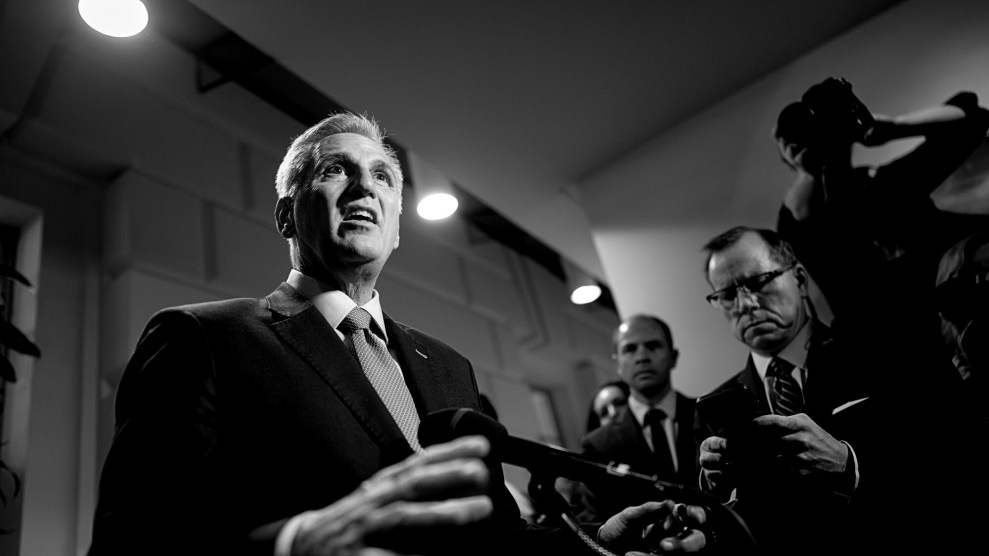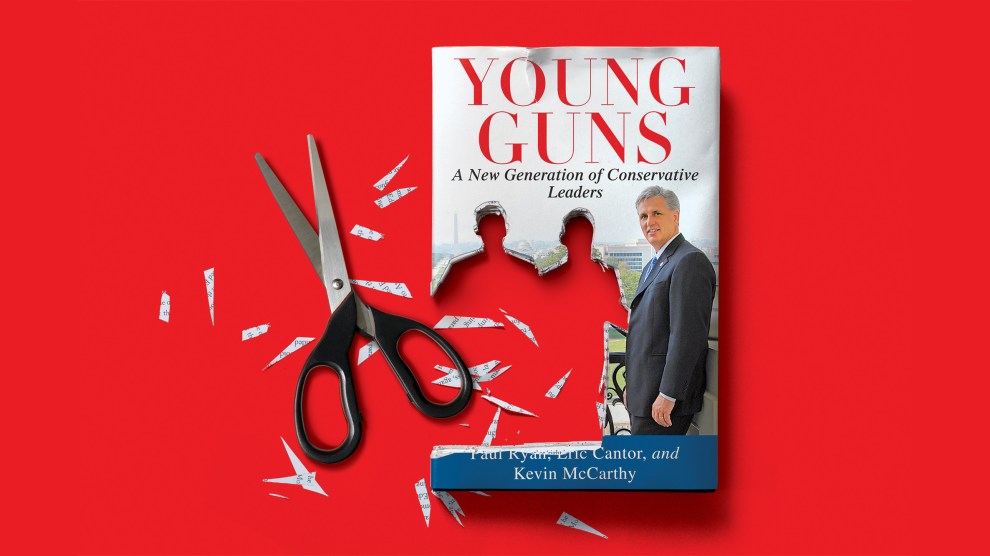
Jacquelyn Martin/AP
On April 15, 2009, Rep. Kevin McCarthy, the California Republican, brought Rep. John Boehner of Ohio, the leader of the House GOP caucus, to a rally in his home town of Bakersfield. It was Tax Day, and in 200 or so cities across the nation, a new political force called the tea party was staging raucous demonstrations. This conservative movement had sprung into existence two months earlier, initially as grassroots opposition to government bailouts enacted to protect the economy after the financial crisis of 2007 and 2008. Yet with the support of right-wing establishment outfits, such as Fox News, the Young Republicans, the Heritage Foundation, and FreedomWorks, it quickly morphed into an angry protest of the new president, Barack Obama, the Democratic-controlled Congress, their economic stimulus plan, and much more.
At these mad-as-hell events, where suburbanites dressed up in colonial outfits, there was a disturbing element: signs depicting Obama as the bloody-smiling Joker or Hitler. And others: “Obama Is the Anti-Christ.” “The American Taxpayers Are the Jews for Obama’s Ovens.” “Stand Idly By While Some Kenyan Tries to Destroy America?… Homey Don’t Play Dat!!!” Participants waved Confederate flags. Attendees shared with reporters assorted conspiratorial beliefs that could be summed up in one ominous right-wing fantasy: Obama was a secret Muslim born in Kenya who was in league with shadowy elites and purposefully trying to destroy the nation by increasing the deficit and forcing an economic collapse he could use to impose a totalitarian regime.
The protesters were a crazy quilt of the right: anti-government advocates, militia people, Christian nationalists, abortion-rights foes, opponents of gun safety measures, libertarians, birthers, social conservatives, and veterans of the so-called Patriots movement of the 1990s. A bit of the old New Right and the Christian right—with even more anger. A central organizing principle appeared to be hatred of Obama and an irrational fear of impending tyranny and doom.
When Republican extremists forced McCarthy out of the House speakership on Tuesday, they were following a course that McCarthy himself had set for the GOP this very day. He was steering his party into the waters of far-right radicalism. Years later, he would drown in them.
At the Bakersfield gathering, McCarthy introduced Boehner, an old-school, country-club conservative, to this new movement propelled by paranoia and extremism. For Boehner, the rally was a wake-up call—or a warning. As journalist Robert Draper later put it, “Boehner had never seen anything like it—an outcry of anti-Washington vitriol bordering on the elemental—and immediately recognized that he could either board this train or be flattened by it.” These folks were not looking for the Republicans to legislate. Many tea partiers considered the GOP part of the turncoat establishment that was betraying the nation. They yearned for Republicans willing to wage all-out war against Obama, the commie libs, the corrupt elites, and whoever the hell else was destroying their US of A.
McCarthy had led Boehner to what looked to be the promised land for the GOP. If Boehner and the Republicans could harness this energy, they could in the coming midterm elections seize control of Congress. To do so, the Republicans would have to accept and encourage foul and conspiratorial currents. That was a price Boehner and McCarthy were willing to pay for power. But doing so would place both men on the path to failure.
After the Bakersfield rally, Boehner, McCarthy, and other GOP leaders fully embraced the tea party, despite its extremism and craziness. When Glenn Beck, a Fox host who became an unofficial leader of this movement, railed against Obama, wildly claiming that the president hated white people and was setting up concentration camps for his political enemies as part of his plan to impose a dictatorship, Boehner and other top Republicans appeared on Beck’s show and validated him as an important information source for the GOP base. Republican leaders spoke at tea party rallies where protesters held signs with racist and antisemitic slogans. Boehner addressed one crowd that shouted, “Nazis, Nazis” at the mention of Democrats, and he echoed the tea party’s hyperbolic opposition to Obama’s proposed health care plan, calling it “the greatest threat to freedom I have ever seen.”
Boehner counseled his fellow Republicans to find ways to court the tea partiers, who were worked up about (nonexistent) “death panels,” birtherism, and assorted global conspiracies. After Rep. Bob Inglis, a conservative South Carolina Republican, was defeated in the GOP primary in 2010 by tea party favorite Trey Gowdy, he told me that Boehner’s attempt to use the tea party to win the House was perilous: “It’s a dangerous strategy to build conservatism on information and policies that are not credible.”
McCarthy was Boehner’s wing man on this mission. Boehner assigned McCarthy the task of crafting a “Pledge to America” for GOP congressional candidates that would appeal to tea party voters. It called for repealing Obamacare (without proposing a replacement) and slashing federal spending.
The Boehner-McCarthy plan worked. House Republicans picked up a whopping 64 seats in the 2010 midterms and took control. But there was a rub. Many of the tea party-backed newbies were not interested in legislating. They aimed to disrupt and cause chaos. They precipitated crises, threatening government shutdowns and federal default (by refusing to go along with the routine procedure of raising the debt ceiling). A veteran Republican congressional staffer observed, “To be sure, like any political party on Earth, the GOP has always had its share of crackpots… But the crackpot outliers of two decades ago have become the vital core today.” Years later in his memoir, Boehner, looking back on this class of 2010, would say, “They didn’t really want legislative victories. They wanted wedge issues and conspiracies and crusades.” A chief concern was how their actions played on Fox or on social media. They were, according to Boehner, “just thinking of how to fundraise off of outrage or how they could get on Hannity that night.” Their goal was to increase the tribalist toxicity of American politics. And they had been guided into the party by Boehner, McCarthy, and others.
In the years ahead, the influence of the tea party-ish Republicans within the House GOP caucus grew, and come 2015, Boehner left the speakership before he could be defenestrated by the radicals. (In a 2014 GOP primary contest, a little-known tea party-favored candidate had defeated Rep. Eric Cantor, the No.2 House Republican, after pummeling Cantor for daring to seek a bipartisan agreement on immigration.) When Boehner gave up the gavel, McCarthy expressed his interest in the post, but the House Freedom Caucus—which had been founded by the tea partiers he had helped become House members—opposed McCarthy, and he withdrew his name from consideration. The fellow who won the job, Rep. Paul Ryan of Wisconsin, had numerous tussles with the extremists and quit in 2018 before the GOP lost the House. McCarthy became something of a speaker-in-waiting.
Meanwhile, the tea party had evolved into Trumpism, and the far-right of the GOP became more extreme, as it embraced Donald Trump, his lies, and his authoritarian impulses and transformed into a cult of personality. (Trump had emerged as a far-right champion by peddling the racist birth conspiracy theory popular among tea partiers.) Responsible and stable governance, respectful discourse, preservation of democratic norms—none of that was a priority. To remain a contender for speaker, McCarthy, after the Trump-incited January 6 insurrectionist riot, had to continue to ally himself with Trump and endorse his Big Lie that the 2020 election had been stolen from him. That meant McCarthy was striving to lead a party predicated on falsehoods and conspiracism that backed a demagogue who had tried to mount a coup and overturn an American election.
After the Republicans barely won the House in 2022, McCarthy got what he craved. But he was now the head of a political party rooted in lies, violence, and chaos. Worse, to gain the speakership, he had cut a deal with the most extreme members of the GOP caucus—the sort of Republicans he had welcomed into the party in 2010—and he handed them control of his fate. No one who hopes to govern reasonably can have a lifeline attached to a Trump extremist, such as Rep. Matt Gaetz.
The tale of Kevin McCarthy is no Greek tragedy. His departure from the third-highest position in the US government was not a sad day for America. It was confirmation of one of the world’s oldest platitudes: You reap what you sow. In this case, 14 years ago, McCarthy exploited an eruption of far-right grievance, paranoia, racism, and irrationality. With this move, he and Boehner succeeded in gaining political control but further corrupted the soul of the party (Newt Gingrich, Sarah Palin, and others had earlier encouraged extremism within the party). A straight line runs from the tea party to Trump. And just as the tea party Republicans chased Boehner out of the speakership, the Trumpiest Republicans of today devoured McCarthy, who long ago had opened the gates to this extremism.
It took over a decade for the cynical calculations of his past to catch up to McCarthy. But with his support of the tea party and, then, Trump he bolstered the conditions that yielded his ruin. He helped turn the Republican Party into a threat to American democracy. It’s fitting that he became a victim of his own creation.
Portions of this article were drawn from David Corn’s American Psychosis: A Historical Investigation of How the Republican Party Went Crazy, which was recently released in an expanded paperback version.
















